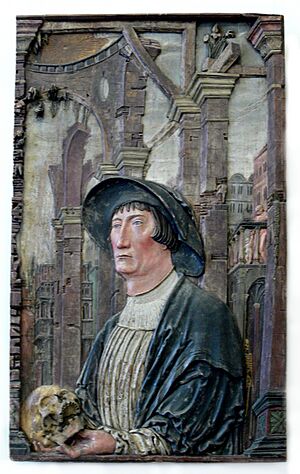Tiedemann Giese facts for kids
Quick facts for kids
Tiedemann Giese
|
|
|---|---|

Tiedemann Giese, around 1525–1530, painting by Hans Schenck
|
|
| Born | 1 June 1480 Danzig (Gdańsk), Kingdom of Poland
|
| Died | 23 October 1550 Lidzbark (Heilsberg)
|
| Occupation | Theologian author, Bishop of Chełmno, Prince-Bishop of Warmia (Ermland) |
|
Notable work
|
|
Tiedemann Giese (June 1, 1480 – October 23, 1550) was a very important person in history. He was first a Bishop of Kulm (Chełmno) and later a Prince-Bishop of Warmia (Ermland). He loved mathematics, astronomy, and theology. He also helped many young scholars, including the famous Nicolaus Copernicus. Tiedemann Giese was a great writer and often corresponded with others. He came from a rich family in Danzig (now Gdańsk). His family originally came from a town called Unna in Germany. His father was Albrecht Giese, and his younger brother was Georg Giese, a merchant.
Contents
Early Life and Education
Tiedemann Giese was the fifth child in his family. His parents, Albrecht Giese and Elisabeth Langenbeck, came from wealthy merchant families. His father was even the Mayor of Danzig. His mother's uncle, Johann Ferber, had also been a Mayor of Danzig.
When Tiedemann was 12 years old, he went to the University of Leipzig. He also studied in Basel, Switzerland, and in Italy. He earned a Master's degree in theology. Giese was one of the smartest scholars in Prussia. He knew a lot about both religion and science.
Becoming a Priest and Bishop
At age 24, Tiedemann Giese became a priest in the Catholic Church. He served at the Church of St. Peter and St. Paul.
He worked as a secretary for the King of Poland. Later, he became a canon (a type of priest) in Frauenburg (Frombork). He stayed there for 30 years. His home was the Bishop's Castle in Frauenburg. The King appointed him Bishop of Kulm in 1537. Later in his life, he became the Bishop of Ermland.
Friendship with Nicolaus Copernicus
Bishop Giese was a close friend of the famous astronomer Nicolaus Copernicus. They shared a love for astronomy. Giese was a very wealthy man, so he owned excellent astronomy tools. He often lent these tools to Copernicus. Giese was seven years younger than Copernicus but was smart enough to understand Copernicus's studies.
Giese even bought Copernicus a special sundial. He also gave him a tool to observe the equinoxes (when day and night are equal). Another mathematician, Rheticus, wrote about Giese's amazing astronomy tools.
Encouraging New Ideas
Tiedemann Giese strongly encouraged Copernicus to publish his ideas about how the planets move around the sun. Copernicus wrote in his book that Giese and other friends helped him a lot. They supported him and urged him to share his discoveries with the world.
Political Involvement and Views
In 1516, Giese and Copernicus wrote a letter together to the Polish King Sigismund I the Old. They asked the King to protect Prussia from the Teutonic Knights. Giese always supported the interests of the Polish Crown.
Danzig had been part of the Teutonic Order's state since 1308. In 1466, Danzig became part of the Kingdom of Poland again. It kept a lot of its independence, like having its own judges and making its own money.
Giese also helped update the Kulm law, which was a set of rules for the region. King Sigismund I thought Giese was a very good diplomat. After another bishop, Mauritius Ferber, died, Giese became a prince-bishop.
Religious Tolerance
Giese was a very open-minded person, much like the famous scholar Erasmus. Even though he was a Catholic, he was quite tolerant of Lutherans. He wanted to bring together the "old-believers" (Catholics) and "new-believers" (Protestants). He wrote about his goal to reunite the different parts of the church.
A Prolific Writer and Friend
People who knew Giese described him as a very religious, learned, and loyal friend. They said he was generous and helped those in need. Nicolaus Copernicus called Giese a "devoted friend" who had "the greatest zeal for the divine and the liberal arts."
Giese wrote many letters and books. He often wrote to young, smart scholars, encouraging them and following their careers. In the introduction to his famous book, De revolutionibus, Copernicus thanked Giese for pushing him to publish his theories.
Giese also wrote to other famous thinkers like Erasmus of Rotterdam, the reformer Philip Melanchthon, and the philosopher Damião de Gois.
Notable Works
Some of Giese's known writings include:
- Centum et decem assertiones, quas auctor earum Flosculos appellavit de homine interiore et exteriore
- Antilogikon, which argued against the Lutheran reformer Johann Briesmann.
- De Regno Christi, where he imagined a church that was reformed and reunited. Only parts of this book still exist.
- He also wrote a paper defending Copernicus's ideas about how planets move.
Most of his other works are now lost, including a paper about the ancient philosopher Aristotle.
Legacy and Death
When his friend Copernicus died in 1543, he left his writings to Giese. Copernicus also left his library to the church in Ermland. Bishop Giese died in Heilsberg (Lidzbark) in 1550. He was buried next to Copernicus in the Frauenburg (Frombork) cathedral.
Works
- Antilogikon flosculorum Lutheranorum (1523)
- Anacrisis nominis Jesus (1542)
Sources
- Teresa Borawska, Tiedemann Giese (1480–1550) w życiu wewnętrznym Warmii i Prus Królewskich [Tiedemann Giese (1480–1550) in the Internal Life of Warmia and Royal Prussia, Olsztyn, 1984.
| Catholic Church titles | ||
|---|---|---|
| Regnal titles | ||
| Preceded by Johannes Dantiscus |
Bishop of Warmia (Ermland) 1549–1550 |
Succeeded by Stanislaus Hosius |

